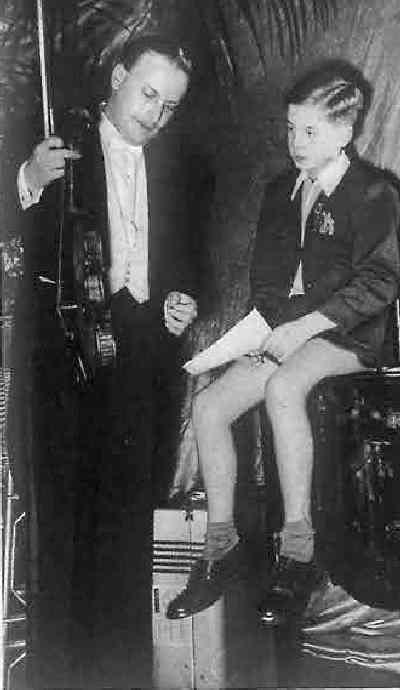
Figure 1.--Pierino Gamba appears here with noted violinist Yehudi Menuhin, a former child prodigy himself. Pierino continued wearing short pants even as an older teenager--presumably to help maintain his status as a child prodigy.

The personal experiences of these boys make for interesting reading. One can only wonder what it must have been like to start composing music when you were only 2 years old and go on to actually create an opera at age ten as Samuel Barber did? The available accounts are
astonnishing. World-renowned percussionist Evelyn Glennie went deaf when she was 8 years old and yet went on to persue a brilliant career.
Long hair and ringlet curls a well as juvenile clothing were more
likely than not to be worn by boys who were considered to be child prodigies in order to prolong their status. A child prodigy often had commercial value which was lost once he became to old. A 5 year boy preacher would be amazing. A 10-year dressed in a suit with a short haircut a great deal less so. There are many examoles. Felix Mendolson had
long hair and worn childish clothes until he was 13. I don't know if he ordinarly worn these clothes everyday but as he got older he continued to perform in clothes suitabe for a 6 year old.
A book of short stories by German novelist Thomas Mann titled: The Infant Prodigy. The fictionalized story provides insights on what it was like to be a child prodigy. It begins:
The prodigy entered. The hall became quiet. It became quiet and then the audience began to, clap, because somewhere at the side a leader of mobs, a born organizer, clapped first. Ile audience had heard nothing yet, but they applauded; for a mighty publicity organization had heralded the prodigy and people were already hypnotized, whether they knew it or not.The prodigy came from behind a splendid screen embroidered with Empire garlands and great conventionalized flowers, and climbed nimbly up the steps to the platform, diving into the applause as into a bath; a little chilly and shivering, but yet as though into a friendly element. He advanced to the edge of the platform and smiled as though he were about to be photographed; he made shy childish charming gesture of greeting, like a little girl.
He was dressed entirely in white silk, which the audience found enchanting. The little white jacket was fancifully cut, with a sashunderneath it, and even his shoes were made of white silk. But against the White socks his bare little legs stood out quite brown; For he was a Greek boy.He was called Bibi Saccellaphylaccas. And such indeed was his name. No one knew what Bibi was the pet name for, nobody but the impresario, and he regarded it as a trade secret. Bibi had smooth black hair reaching to his shoulders; it was parted on the side and fastened back from the narrow domed forehead by a little silk bow. His was the most harmless childish countenance in the world, with an unfinished nose and guileless mouth. The area beneath his pitch-black mouse-like eyes was already a little tired and visibly lined. He looked as though he were nine years old but was really eight and given out for seven. It was hard to tell whether to believe this or not. Probably everybody knew better and still believed it, as happens about so many things. The average man thinks that a little falseness goes with beauty. Where should we get any excitement out of our daily life if we were not willing to pretend a bit? And the average man is quite right, in his average brains!. [Thomas Mann, "Stories of Three Decades", Alfred A Knopf, Inc, 1936. Original version in German, 1897.]
One of the best source of information on prodigies is Musical Prodigies: Perilous Journeys, Remarkable Lives by Claude Kenneson. Van Cliburn even wrote a forward. The author explores early family life, first teachers, the importance of peers, and the inevitable struggles for independence and acceptance as an adult musician. For some, the promise of childhood was borne out, the difficult passage through adolescence successfully weathered. For others, fate dealt a different hand. In a fascinating conclusion to the
volume, Bejun Mehta offers an insider's view. His is the remarkable story of a celebrated boy soprano who struggled to find his muse again after his voice changed. His insights illuminate many wondrous elements of the prodigy's experience. Parents and families of gifted children in all the arts will welcome these insights into the many wondrous elements of the prodigy's experience. This is a celebration of the remarkable lives of 44 musical prodigies from the 18th century to the present, including the amazing stories of Mozart and Paganini, Andrés Segovia and Samuel Barber, Van Cliburn and Ruggiero Ricci, Shauna Rolston and Yo-Yo Ma, to name only a few. The author of this excellent book on prodigies is Claude Kenneson who is a cellist and professor emeritus of the University of Alberta who has nurtured several prodigies among his own cello students. Besides this important book there are several valuable works on the experience of prodigies as well as individual prodigies.
Navigate the Historic Boys' Clothing Web Site:
[Return to the Main prodigy page]
[Introduction]
[Activities]
[Bibliographies]
[Biographies]
[Chronology]
[Clothing styles]
[Contributions]
[Boys' Clothing Home]
Related Chronolgy Pages in the Boys' Historical Web Site
[Main Chronology Page]
[The 1860s]
[The 1870s]
[The 1880s]
[The 1890s]
[The 1900s]
[The 1910s]
[The 1920s]
[The 1930s]
[The 1940s]
[The 1950s]
[The 1960s]
Navigate the Historic Boys' Clothing Web style pages:
[Kilts]
[Caps]
[Sailor suits]
[Sailor hats]
[School uniform]
[Scout]
